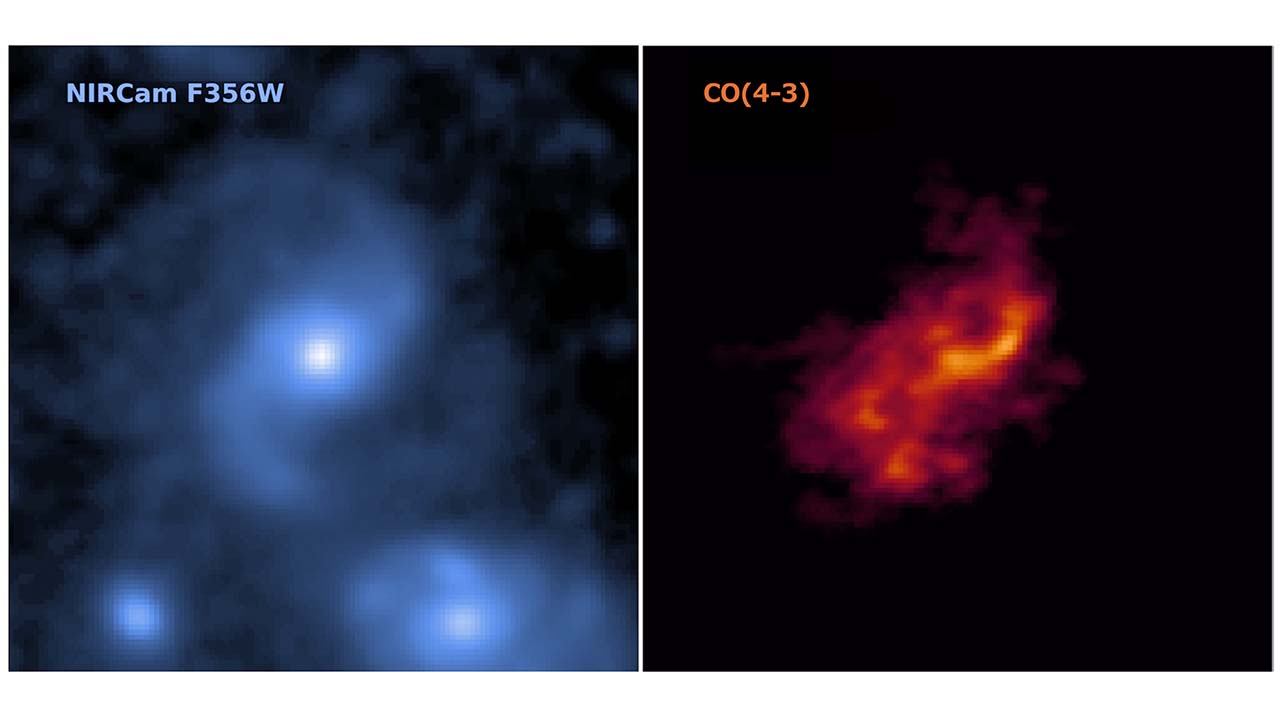2025-05-22 国立天文台
 「J0107a」銀河。左は、ジェイムズ・ウェッブ宇宙望遠鏡(JWST)の観測による近赤外線画像。画面下の2つは近距離にある天体。(クレジット:NASA)右は、アルマ望遠鏡によって観測されたガスの分布。棒状構造は時計回りに回転している。大量のガスが、回転の前方の縁から中心に向かって落ち込んでいる。(クレジット:ALMA(ESO/NAOJ/NRAO), Huang et al.)
「J0107a」銀河。左は、ジェイムズ・ウェッブ宇宙望遠鏡(JWST)の観測による近赤外線画像。画面下の2つは近距離にある天体。(クレジット:NASA)右は、アルマ望遠鏡によって観測されたガスの分布。棒状構造は時計回りに回転している。大量のガスが、回転の前方の縁から中心に向かって落ち込んでいる。(クレジット:ALMA(ESO/NAOJ/NRAO), Huang et al.)
<関連情報>
- https://www.nao.ac.jp/news/science/2025/20250522-alma.html
- https://alma-telescope.jp/news/press/gbsgalaxy-202505.html
- https://www.nature.com/articles/s41586-025-08914-2
初期宇宙における成熟銀河バーによる大規模なガス流入 Large gas inflow driven by a matured galactic bar in the early Universe
Shuo Huang,Ryohei Kawabe,Hideki Umehata,Kotaro Kohno,Yoichi Tamura & Toshiki Saito
Nature Published:21 May 2025
DOI:https://doi.org/10.1038/s41586-025-08914-2
Abstract
Bar structures are present in about half of local disk galaxies1 and play pivotal roles in secular galaxy evolution. Bars impose a non-axisymmetric perturbation on the rotating disk and transport gas inwards to feed the central starburst and, possibly, the activity of the nuclear supermassive black hole2. They are believed to be long-lived structures3,4 and are now identified at redshift z > 2 (refs. 5,6). However, little is known about the onset and effects of bars in the early cosmic epoch because the spectroscopy of distant bars at sufficient resolution is prohibitively expensive. Here we report on a kinematic study of a galactic bar at redshift 2.467, 2.6 billion years after the Big Bang. We observed the carbon monoxide and atomic carbon emission lines of the dusty star-forming galaxy J0107a and found the bar of J0107a has gas distribution and motion in a pattern identical to local bars7,8,9. At the same time, the bar drives large-scale non-circular motions that dominate over disk rotation, funnelling molecular gas into its centre at a rate of approximately 600 solar masses per year. Our results show that bar-driven dynamical processes and secular evolution were already at play 11.1 billion years ago, powering active star formation amid the gas-rich and far-infrared luminous growth phase in a massive disk galaxy.



